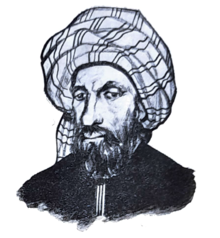
Back Avempace AN ابن باجة Arabic ابن باجه ARZ ابن باجه AZB Ибн Баджа Bulgarian ইবনে বাজা Bengali/Bangla Avempace Catalan ئیبن باجە CKB Avempace Czech Ibn Baddscha German
Ibn Bajja Ibn Bājja | |
|---|---|
ابن باجة | |
 An imaginary sketch representing Ibn Bajja, 1961 | |
| Born | c. 1085 |
| Died | 1138 (aged 52–53) |
| Nationality | Andalusi[1] |
| Scientific career | |
| Fields | Astronomer, philosopher, physician, physicist, poet, scientist[1] |
Abū Bakr Muḥammad ibn Yaḥyà ibn aṣ-Ṣā’igh at-Tūjībī ibn Bājja (Arabic: أبو بكر محمد بن يحيى بن الصائغ التجيبي بن باجة), best known by his Latinised name Avempace (/ˈeɪvəmpeɪs/;[2] c. 1085 – 1138), was an Andalusi polymath,[1] whose writings include works regarding astronomy, physics, and music, as well as philosophy, medicine, botany, and poetry.[1][3]
He was the author of the Kitāb an-Nabāt ("The Book of Plants"), a popular work on botany, which defined the sex of plants.[4] His philosophical theories influenced the work of Ibn Rushd (Averroes) and Albertus Magnus.[1] Most of his writings and books were not completed (or well-organized) due to his early death. He had a vast knowledge of medicine, mathematics, and astronomy. His main contribution to Islamic philosophy was his idea on soul phenomenology, which was never completed.
Avempace was, in his time, not only a prominent figure of philosophy but also of music and poetry.[5] His diwan (Arabic: collection of poetry) was rediscovered in 1951. Though many of his works have not survived, his theories in astronomy and physics were preserved by Moses Maimonides and Averroes respectively,[1] and influenced later astronomers and physicists in the Islamic civilization and Renaissance Europe, including Galileo Galilei.[6]
Avempace wrote one of the first (argued by some to be the first) commentaries on Aristotle in the Western world. While his work on projectile motion was never translated from Arabic to Latin, his views became well known around the Western world and to Western philosophers, astronomers, and scientists of many disciplines. His works impacted contemporary medieval thought, and later influenced Galileo and his work. Avempace's theories on projectile motion are found in the text known as "Text 71".[7]
- ^ a b c d e f g Montada, Josép Puig (Summer 2022). "Ibn Bâjja (Avempace)". In Zalta, Edward N. (ed.). Stanford Encyclopedia of Philosophy. The Metaphysics Research Lab, Center for the Study of Language and Information, Stanford University. ISSN 1095-5054. OCLC 643092515. Archived from the original on 10 July 2022. Retrieved 18 July 2022.
- ^ "Avempace".
- ^ Jon Mcginnis, Classical Arabic Philosophy: An Anthology of Sources, p. 266, Hackett Publishing Company, ISBN 0-87220-871-0.
- ^ Cite error: The named reference
:12was invoked but never defined (see the help page). - ^ D. M. Dunlop, "The Dīwān Attributed to Ibn Bājjah (Avempace)", Bulletin of the School of Oriental and African Studies, University of London Vol. 14, No. 3, Studies Presented to Vladimir Minorsky by His Colleagues and Friends (1952), pp. 463
- ^ Ernest A. Moody (April 1951). "Galileo and Avempace: The Dynamics of the Leaning Tower Experiment (I)", Journal of the History of Ideas 12 (2), p. 163-193.
- ^ Franco, Abel B. (October 2003). "Avempace, Projectile Motion, and Impetus Theory". Journal of the History of Ideas. 64 (4): 521–546. doi:10.1353/jhi.2004.0004. ISSN 0022-5037. JSTOR 3654219. S2CID 170691363.
© MMXXIII Rich X Search. We shall prevail. All rights reserved. Rich X Search